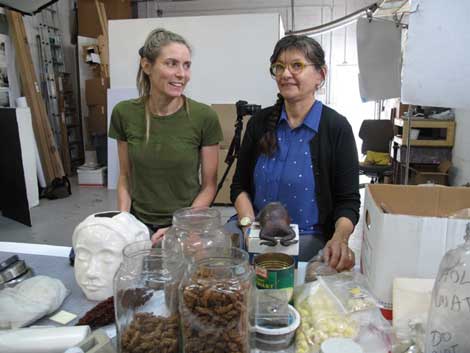Some might see this as a magnificent moment in art history, a modern-day renaissance that seemingly knows no commercial bounds. Possibly even a new art movement. Sure we have seen and talk about bubbles bursting—yet new technology, benefactors’ deep pockets and artists with immeasurable ambition have set the stage for the creation of heroic works. While our multitasking world of over-the-top stimulus may have left us desensitized to the grandiose, artists have more at their disposal than ever before. The present-day aesthetic is obliged to nothing. Couple this with the backing of a small army during production, and we have created a recipe for something spectacular, something truly monumental. Artists have the ability to create that which will be clamored over for generations to come—all you need is an idea that can fill an aircraft hangar and the financial backing to pay the right team of fabricators.
But what do we sacrifice? Through mass production, through outsourcing, through big budget projects on compressed timelines, I think it would be hard to argue if we are not very careful, that the artwork eventually will become diluted.
Yet I find myself wanting to yell at those on top of the mountain, “Impress us, go bigger!” Let us see what you really can do. Make something epic. Call in the engineers, get the cranes and welders—go ahead, carve out your place in history. For better or worse, as with much in this progress-fueled world, the crux of the question is not “Should we?” But rather “Can we?”
In this issue of Artillery, we explore what it takes to produce contemporary art. Highlighting each of the many facets of the “behind the scenes” making, we delve into much more than the simple logistics behind taking an artwork from concept to finished object. Conversations with artists, fabricators and assistants help to illuminate the current state of affairs, showing that “some assembly is definitely required” in the process of making art in a global economy.
A career artist who has been there and done that—from creating colossal outsourced works to those as intimate as replicating a simple popcorn kernel—is sculptor Charles Long. Long has now left the world of goliath-scaled production in favor of a return to the studio, to getting his hands dirty in each piece, no assistants needed. The inverse of this mentality is fabricator-for-hire Chas Smith. Chas has played a pivotal role in making some of the most noted works by today’s hottest artists. He is the one you call when the piece is meant to be a true spectacle, the size of a building with zero margin for error.
For those who don’t make objects the size of a building, but rather cover an entire building facade with their art, a large crew is a necessity. Nicholas Bowers, Shepard Fairey’s longtime right-hand man, chats about what it is like to run the team for a globe-trotting art superstar.
What is the link that exists between the assistant and the successful artist? Does one often evolve into the other in some echo of a traditional apprenticeship scenario? We speak with emerging artist Christian Tedeschi about his current work and how his time assisting Los Angeles art royalty helped to shape his process.
Through the long days spent in the studio, deep tangible relationships develop. Kim Abeles and Rebecca Ripple exemplify this, having transitioned from working together as artist and assistant, to their current state much more like the art version of comrades-in-arms. Finally, there are the unsung heroes—the people that live solely “behind the scenes.” For this, Artillery would like to tip our hat to Fred Stecher, longtime bronze public art fabricator.
When looking logically at this current model of production, we need not worry if this is a new issue, but rather, at what cost does it come? When do we acknowledge that the overproduction of truly unique art objects causes them to actually lose their uniqueness?
I am a proponent of the grand gesture, of epic art-making. But there is a striking difference between monumental projects and mass production. Question is, can we tell the difference?





















0 Comments